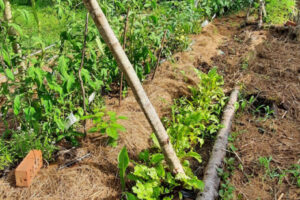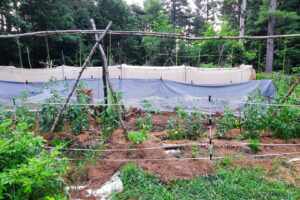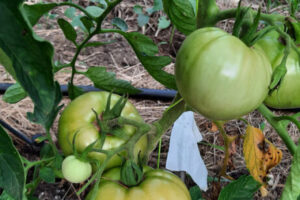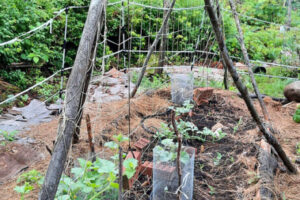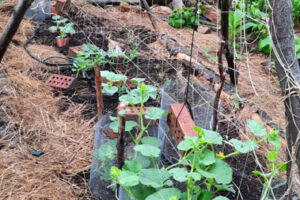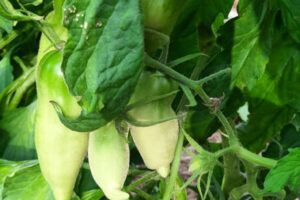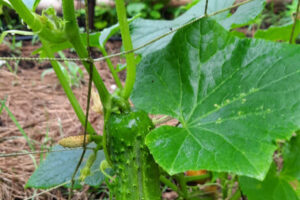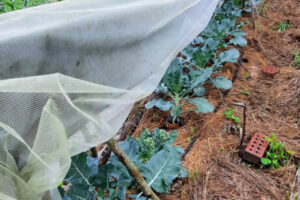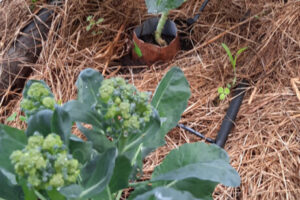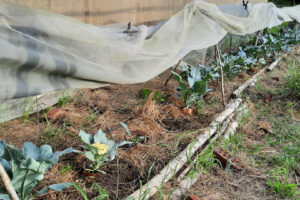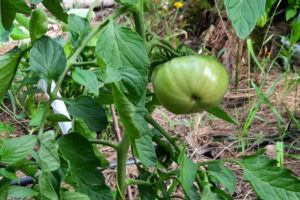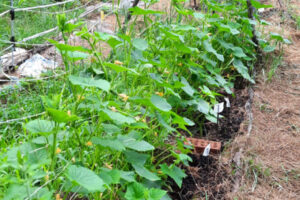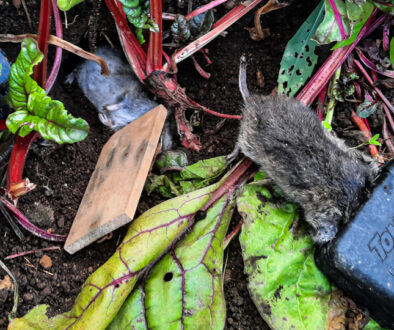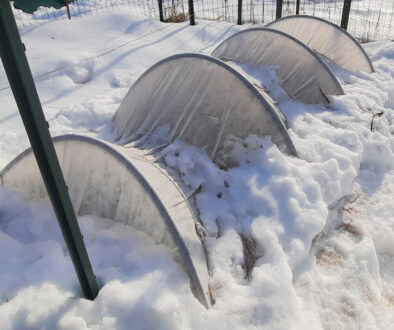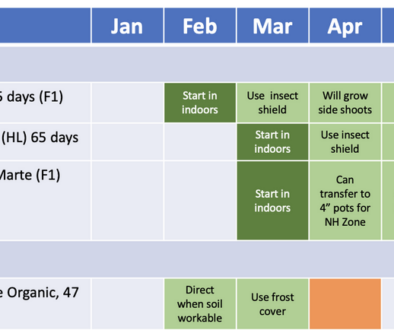July in the Vegetable Garden
This month things slow down a bit. March, April, May, and June were extremely busy and I haven’t gotten to this blog since February.
Beans. My biggest complaint is a bunny got to the beans, both in NH and MA. Still growing but to late to plant another beean crop though I’m tempted due to this global warming. I should have 90 days left in the season. Must be more diligent on applying repellent, bone or blood meal – this will help keep them away.
Brussles. The biggest success has been the one-dollar-a-seed Brussels sprouts – long story. Wasn’t going to plant this year but someone wanted it for late-season wildlife feed.
Tomatoes. Great in both gardens as well as some plants I gave away. I put 10 tomato plants in a 4×8 raised bed so I’m fertilizing every week with mag-cal and fish and seaweed. Also in the bed are basil, celery, and a row of onions down the center.
Cukes. Doing great in NH on trellis net strung between two tripods – third-year use. In Ma late start. Seems the soil needs amending, but growing well enough with the help of fish and seaweed fertilizer.
Potatoes. The 4×8 raised bed in MA was planted in Feb or March with the crop from the previous season. with leaves and a frost cover. We harvested some after flowers started showing, they were golf ball size or small. Decided to thin and wait for die back.
In NH we planted 2 small rows. I clipped the flowers back on the lower row, as I heard, potatoes will early flower if the weather is unusually warm making the potatoes small. Clipping the flowers makes bigger potatoes – supposedly – time will tell. there are conflicting beliefs on this.
Onion. I am in the second year of mastering the onion. We did OK last year in a 4×5 bed, about tangerine size. This year tried a no-dig method, whereas the year before at the end of the season I fertilized with composted manure, covered with paper, and mulched with hay. As enabling us to just open a little hole and plant the seedling. I purchased a red (red Zepline) and a white onion from SPider Web in Tuftonbougho which were grown individually in a six-pack. They were much larger and growing much better than the ones I started grouped in a 6 inch pot.
Winter Squash. Butternuts – three hills with about 3-4 plants, companion planted with nasturtium (aphid trap) and radish (flowers confuse harmful insects). Still trying to understand this relationship but seems to work. Pumpkins – I have one giant hill with three medium pumpkins and 3-4 small pie pumpkins. I had to re-seed several times as the rodents were digging the seeds. These pests need to be reduced before the fruit sets as they will get eaten by the rodents.
Before the plants flower, I apply the dreaded awful pesticide Sevin (or Eight) the the base of the stem to manage boring insects. Sevin is toxic, timing is essential.
Summer Squash. Have harvested several medium-sized zucchini. I have two plants in MA and soon to bee two plants in NH.
Beets. Still need to master beets. Seems the insect and rodent world loves them as much as I do. They seem to be doing OK in NH.
Okra. Replanted a couple of weeks ago. they are about 6 inch seedling right now. Wish I planted them sooner.
Peppers. Successful in MA. Plenty of water is needed. Could haves now but waiting to turn red. Growing Hungarian spice peppers and looking forward to what that becomes. Had flea beatle damage and dusted a little eight as night.
Weeding, Weeding, Weeding!
Not too much to be said. Adding more salt marsh hay where needed.
Keeping an eye on insects.
The fruit trees and grapes are getting sprayed with spinosad, and neem and next BT in two-week cycles. I netted the brasicas and reduced leaf hopper damage. As soon as I see those white moths bouncing about I give a light spray over the cabbages through the netting.
Pesticides.
I try to stay as organic as possible (you know strychnine is organic, so don’t think organic is always safe). And apply insecticide when necessary and before an infestation happens. The garden needs to be checked EVRY DAY for insects and insect damage.
Go to pesticides.
Spinosad. Relatives new to me, supposedly a chemical form of pyrethrum. I use this with a spray on the end of a hose in April to deter ticks, applying it to the perimeter of the garden and wooded area nearby. I use this on the fruit trees.
Pyrithrum. Derived from a chrysanthemum. General use. Japanese beeltes.
Dish soap. Dawn platinum. A teaspoon in a quart. Worked great on keeping bees away while I sealed up the clappording on the side of the house. Smells good too.
Neem. Use on pot plants. OK for soft-bodied insects, and supposedly reduces mildew. (jury still out). Not seeing this as very useful but the bugs seem to be less than in other years. But that may be for other environmental reasons.
BT. Bacillus thuringiensis. Biological weapon for wormy pests, caterpillars, and the like.
There are others but I don’t try to use anything too toxic, besides all the good stuff you need a license to acquire and use.
Need to remember splitting between MA and NH leaves several days between inspections. Luckily I have someone to water every day, but the rest is up to me.
Fertilizer.
Keeping a healthy plant will help deter insects.
Fish and seaweed every two weeks on everything, except in the over-crowded 4×8 raised bed (one a week). Cag-mag on the tomatoes and brassicas.
Succession planting.
Broccoli and cauliflower are finished, pulled, and cleared for the next planting, broccoli had OK primary heads (about 6 inches) and secondary heads (about 4 inches). Cauliflower – as a first-time grow – did amazingly well. MA head was about 7 inches in NH a bit smaller. Very little slug damage due to beer traps, Sluggo, and the new improvized copper collars (used in NH).
Peas finished, left several pods to dry for seed saving. Peas cleared and row ready for new crop. Peas in MA did great, and terrible in NH. Possibly rodents or slugs eating the seedlings.
I
What’s coming to harvest?

